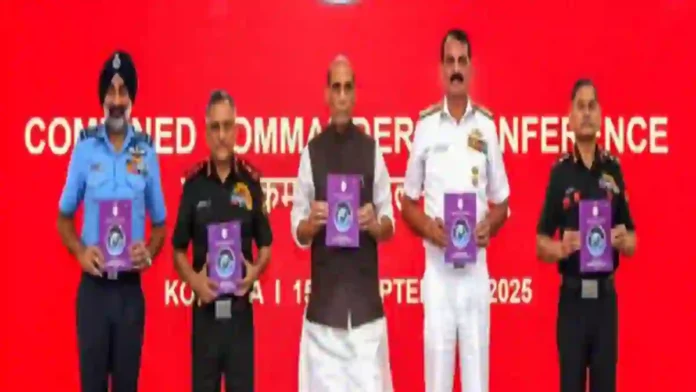India’s armed forces have announced two landmark decisions at the Combined Commanders’ Conference (CCC-2025) in Kolkata, underscoring the government’s Year of Reforms agenda. The first is the creation of three joint military stations, billed as a critical step towards accelerating jointness and paving the way for eventual theatre commands.
Although the specific locations have not been revealed, these stations will follow the model of existing joint logistics nodes already active in Mumbai, Guwahati, and Port Blair, which pool resources and services across the Army, Navy, and Air Force.
Read- Saudi, Pakistan Seal Mutual Defence Pact: Attack On One Deemed Attack on Both
This directly addresses Prime Minister Narendra Modi’s directive for swifter integration to sharpen military preparedness in a rapidly evolving threat landscape.
Parallel to this, the three services agreed to merge their education wings under a Tri-Services Education Corps, a structural reform designed to standardise training, curricula, and professional military education across the armed forces.
This is expected to avoid duplication, streamline decision-making, and ensure a unified approach to doctrine, leadership development, and knowledge-sharing. General Anil Chauhan, Chief of Defence Staff (CDS), chaired the sessions emphasising that such measures are key enablers for India’s Theaterisation journey, interoperability, and readiness.
The conference greatly focused on new-age warfighting domains — cyber, space, information, and special operations — alongside the release of the first-ever Joint Military Space Doctrine, signifying that outer space will now sit firmly within India’s national security strategy.
Read- Su-57E With Zircon: India’s Hypersonic And Air Dominance Edge?
Read- RAFALE DEAL: The First 18 Rafale Fighters To Come Off-The-Shelf With A Shorter Timeline
This becomes critical given China’s aggressive military space developments, including jammers and anti-satellite weaponry. India is simultaneously drafting a national military space policy to harden its space-based assets. The combined reforms represent a shift toward a technology-led and multi-domain force structure, integrating innovations systematically into India’s operational doctrine.
Additionally, the CCC-2025 mapped a clear reform roadmap for 2025, featuring nine priority areas, including Theaterisation, indigenous capability development, simplified acquisition procedures, and space-cyber integration.
The “Year of Reforms — Transforming for the Future” also witnessed the CDS providing updates on reform execution against the timelines set by the Prime Minister and Defence Minister Rajnath Singh, who is undertaking quarterly reviews of reforms including theatre command restructuring. Singh and Modi both underlined that synergy and whole-of-nation approaches are prerequisites for combat readiness in future wars, against the backdrop of inter-service debates on Theaterisation.
The conference concluded with the assertion that 2025’s reforms will set the foundation for India’s armed forces to evolve into a more integrated, agile, and technologically advanced force, capable of countering multi-domain threats, optimising resources, safeguarding national interests, and contributing to regional and global security.
Together, the formation of joint military stations, the education corps merger, and the adoption of the Joint Military Space Doctrine mark major inflection points in India’s long march toward integrated, future-ready armed forces.
Agencies




